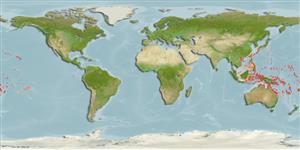Environment: milieu / climate zone / depth range / distribution range
Οικολογία
Θαλασσινό(ά); ωκεανόδρομο(ς); εύρος βάθους 0 - 10 m (Ref. 86942). Tropical; 36°N - 29°S, 105°E - 143°W
Pacific Ocean: southern Japan, Taiwan, Philippines, New Guinea, and eastern Australia up to Hawaiian Islands and Tahiti.
Μέγεθος / Βάρος / Age
Maturity: Lm ? range ? - ? cm
Max length : 38.0 cm TL αρσενικό/απροσδιόριστο; (Ref. 559)
Neritic species.
Life cycle and mating behavior
Maturities | Αναπαραγωγή | Spawnings | Egg(s) | Fecundities | Προνύμφες
Parin, N.V., 1996. On the species composition of flying fishes (Exocoetidae) in the West-Central part of tropical Pacific. J. Ichthyol. 36(5):357-364. (Ref. 27313)
IUCN Red List Status (Ref. 130435)
Threat to humans
Harmless
Human uses
αλιεία: Εμπορικό(ά)
Εργαλεία
Special reports
Download XML
Διαδικτυακές πηγές
Estimates based on models
Preferred temperature (Ref.
123201): 24.5 - 29.3, mean 28.1 °C (based on 2125 cells).
Phylogenetic diversity index (Ref.
82804): PD
50 = 0.5000 [Uniqueness, from 0.5 = low to 2.0 = high].
Bayesian length-weight: a=0.00776 (0.00424 - 0.01421), b=3.05 (2.88 - 3.22), in cm total length, based on LWR estimates for this species & (Sub)family-body (Ref.
93245).
Τροφικό Επίπεδο (Ref.
69278): 3.7 ±0.5 se; based on size and trophs of closest relatives
Ελαστικότητα (Ref.
120179): Υψηλό, ελάχιστος χρόνος για διπλασιασμό πληθυσμού < 15 μήνες (Preliminary K or Fecundity.).
Fishing Vulnerability (Ref.
59153): Low to moderate vulnerability (28 of 100).
Nutrients (Ref.
124155): Calcium = 331 [133, 1,000] mg/100g; Iron = 1.8 [0.9, 4.1] mg/100g; Protein = 17.1 [15.0, 19.0] %; Omega3 = 0.196 [0.085, 0.568] g/100g; Selenium = 40.7 [16.4, 89.2] μg/100g; VitaminA = 26.7 [8.7, 93.5] μg/100g; Zinc = 1.3 [0.9, 2.0] mg/100g (wet weight);
